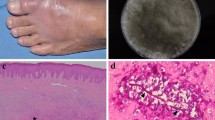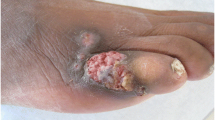Abstract
Phaeohyphomycosis is a chronic infectious disease caused by dematiaceous fungi. It is characterized by the presence of pigmented septate mycelia within tissues. In the case of superficial infection, the lesion(s) chronically evolve(s) toward painless pseudo-tumor(s) of the soft parts. We report herein the original case of a heart transplanted man who exhibited phaeohyphomycosis of the left hand, with no mention of travels in endemic areas. Trematosphaeria grisea was identified as the causative agent, which is quite innovative since this species has been rather described in mycetoma. The antifungal treatment initially based on isavuconazole alone was not sufficient to cure the patient. In contrast, its association with local terbinafine ointment allowed total clinical improvement. This finding is unusual as diagnosis of phaeohyphomycosis caused by T. grisea is uncommon in nontropical countries, and as the outcome appeared successful by the means of add-on therapeutic strategy with terbinafine.




Similar content being viewed by others
References
Ajello L, Georg LK, Steigbigel RT, Wang CJK. A Case of phaeohyphomycosis caused by a new species of Phialophora. Mycologia. 1974;66(3):490. https://doi.org/10.2307/3758492.
Rinaldi MG. Phaeohyphomycosis. Dermatol Clin. 1996;14(1):147–53. https://doi.org/10.1016/S0733-8635(05)70335-1.
Revankar SG, Sutton DA, Rinaldi MG. Primary central nervous system phaeohyphomycosis: a review of 101 cases. Clin Infect Dis. 2004;38(2):206–16. https://doi.org/10.1086/380635.
McCarty TP, Baddley JW, Walsh TJ, Alexander BD, Kontoyiannis DP, Perl TM, Pappas PG. Phaeohyphomycosis in transplant recipients: Results from the transplant associated infection surveillance network (TRANSNET). Med Mycol. 2015;53(5):440–6. https://doi.org/10.1093/mmy/myv018.
Desnos-Ollivier M, Bretagne S, Dromer F, Lortholary O, Dannaoui E. Molecular identification of black-grain mycetoma agents. J Clin Microbiol. 2006;44(10):3517–23. https://doi.org/10.1128/JCM.00862-06.
Ahmed SA, van de Sande WWJ, Stevens DA, Fahal A, van Diepeningen AD, Menken SBJ, de Hoog GS. Revision of agents of black-grain eumycetoma in the order Pleosporales. Persoonia. 2014;33:141–54. https://doi.org/10.3767/003158514X684744.
Kloezen W, Meis JF, Curfs-Breuker I, Fahal AH, van de Sande WWJ. In vitro antifungal activity of isavuconazole against Madurella mycetomatis. Antimicrob Agents Chemother. 2012;56(11):6054–6. https://doi.org/10.1128/AAC.01170-12.
Berg D, Otley CC. Skin cancer in organ transplant recipients: Epidemiology, pathogenesis, and management. J Am Acad Dermatol. 2002;47(1):1–20. https://doi.org/10.1067/MJD.2002.125579.
Revankar SG, Sutton DA. Melanized fungi in human disease. Clin Microbiol Rev. 2010;23:884–928. https://doi.org/10.1128/CMR.00019-10.
Severo LC, Vetoratto G, Oliveira FM, Londero AT. Eumycetoma by Madurella grisea: report of the first case observed in the southern Brazilian region. Revista Do Inst de Med Trop de São Paulo. 1999;41(2):139–42. https://doi.org/10.1590/S0036-46651999000200013.
Vilela R, Duarte OMV, Rosa CA, Castro JGF, Lyon S, Motta RL, Moura ACL. A case of eumycetoma due to Madurella grisea in northern Brazil. Mycopathologia. 2004;158(4):415–8. https://doi.org/10.1007/s11046-004-2844-y.
Revankar SG, Baddley JW, Chen SC-A, Kauffman CA, Slavin M, Vazquez JA, Pappas PG. A mycoses study group international prospective study of phaeohyphomycosis: An analysis of 99 proven/probable cases. Open Forum Infect Dis. 2017. https://doi.org/10.1093/ofid/ofx200.
Liu, D. (2011). Molecular Detection of Human Fungal Pathogens (D. Liu, ed.). 1st ed. CRC Press. https://doi.org/10.1201/b11375.
Ahmed SA, González GM, Tirado-Sánchez A, Moreno-López LM, de Hoog S, Bonifaz A. Nigrograna mackinnonii, not trematosphaeria grisea(syn. Madurella grisea), is the main agent of black grain eumycetoma in Latin America. J Clin Microbiol. 2018;56(3):e01723–e1817. https://doi.org/10.1128/JCM.01723-17.
Chowdhary A, Meis JF, Guarro J, de Hoog GS, Kathuria S, Arendrup MC, Cuenca-Estrella M. ESCMID and ECMM joint clinical guidelines for the diagnosis and management of systemic phaeohyphomycosis: diseases caused by black fungi. Clin Microbiol Infect. 2014;20(S3):47–75. https://doi.org/10.1111/1469-0691.12515.
Hay RJ. Therapeutic potential of terbinafine in subcutaneous and systemic mycoses. Br J Dermatol. 1999;141(s56):36–40. https://doi.org/10.1046/j.1365-2133.1999.00013.x.
Revankar SG, Nailor MD, Sobel JD. Use of terbinafine in rare and refractory mycoses. Future Microbiol. 2008;3(1):9–17. https://doi.org/10.2217/17460913.3.1.9.
Lv GX, Ge YP, Shen YN, Li M, Zhang X, Chen H, Liu WD. Phaeohyphomycosis caused by a plant pathogen Corynespora cassiicola. Med Mycol. 2011. https://doi.org/10.3109/13693786.2011.553635.
Vieira MR, Milheiro A, Pacheco FA. Phaeohyphomycosis due to Cladosporium cladosporioides. Med Mycol. 2001;39(1):135–7. https://doi.org/10.1080/mmy.39.1.135.137.
Rallis E, Frangoulis E. Successful treatment of subcutaneous phaeohyphomycosis owing to Exophiala jeanselmei with oral terbinafine. Int J Dermatol. 2006;45(11):1369–70. https://doi.org/10.1111/j.1365-4632.2006.03077.x.
Neoh CY, Tan SH, Perera P. Cutaneous phaeohyphomycosis due to Cladophialophora bantiana in an immunocompetent patient. Clin Exp Dermatol. 2007;32(5):539–40. https://doi.org/10.1111/j.1365-2230.2007.02461.x.
Arakaki O, Asato Y, Yagi N, Taira K, Yamamoto Y, Nonaka K, Uezato H. Phaeohyphomycosis caused by Exophiala jeanselmei in a patient with polymyalgia rheumatica. J Dermatol. 2010;37(4):367–73. https://doi.org/10.1111/j.1346-8138.2010.00819.x.
Nomura M, Maeda M, Seishima M. Subcutaneous phaeohyphomycosis caused by Exophiala jeanselmei in collagen disease patient. J Dermatol. 2010;37(12):1046–50. https://doi.org/10.1111/j.1346-8138.2010.00973.x.
Hubka V, Mencl K, Skorepova M, Lyskova P, Zalabska E. Phaeohyphomycosis and onychomycosis due to Chaetomium spp including the first report of Chaetomium brasiliense infection. Medical Mycol. 2011. https://doi.org/10.3109/13693786.2011.572299.
Mahajan VK, Sharma V, Prabha N, Thakur K, Sharma NL, Rudramurthy SM, Abhinav C. A rare case of subcutaneous phaeohyphomycosis caused by a Rhytidhysteron species : a clinico-therapeutic experience. Int J Dermatol. 2014;53(12):1485–9. https://doi.org/10.1111/ijd.12529.
Wang L, Wang C, Shen Y, Lv G, She X, Zeng R, Liu W. Phaeohyphomycosis caused by Exophiala spinifera : an increasing disease in young females in mainland China. two case reports and review of five cases reported from mainland China. Mycoses. 2015;58(3):193–6. https://doi.org/10.1111/myc.12295.
Ge H, Pan M, Chen G, Liu X, Shi T, Zhang F. The first case of cutaneous phaeohyphomycosis caused by Bipolaris spicifera in Northern China: a case report. Exp Ther Med. 2017;14(3):1875–8. https://doi.org/10.3892/etm.2017.4765.
Ferrándiz-Pulido C, Martin-Gomez MT, Repiso T, Juárez-Dobjanschi C, Ferrer B, López-Lerma I, García-Patos V. Cutaneous infections by dematiaceous opportunistic fungi : diagnosis and management in 11 solid organ transplant recipients. Mycoses. 2019;62(2):121–7. https://doi.org/10.1111/myc.12853.
Liu H, Zhang J, Chen Y, Xue R, Zeng W, Xi L, Chen Y. Phaeohyphomycosis due to Exophiala spinifera greatly improved by ALA-PDT: a case report. Photodiagn Photodyn Ther. 2019;28:297–9. https://doi.org/10.1016/j.pdpdt.2019.10.002.
Ogawa MM, Peternelli MP, Enokihara MMSS, Nishikaku AS, Gonçalves SS, Tomimori J. Spectral manifestation of melanized fungal infections in kidney transplant recipients : report of six cases. Mycopathologia. 2016;181(5–6):379–85. https://doi.org/10.1007/s11046-016-0005-8.
Cai Q, Lv G-X, Jiang Y-Q, Mei H, Hu S-Q, Xu H-B, Liu W-D. The first case of phaeohyphomycosis caused by Rhinocladiella basitona in an immunocompetent child in China. Mycopathologia. 2013;176(1–2):101–5. https://doi.org/10.1007/s11046-013-9645-0.
Gao LJ, Yu J, Wang DL, Li RY. Recalcitrant primary subcutaneous phaeohyphomycosis due to Phialophora verrucosa. Mycopathologia. 2013;175(1–2):165–70. https://doi.org/10.1007/s11046-012-9602-3.
Tambasco D, D’Ettorre M, Bracaglia R, Massi G, Posteraro B, Torelli R, Capizzi R. A suspected squamous cell carcinoma in a renal transplant recipient revealing a rare cutaneous phaeohyphomycosis by Alternaria infectoria. J Cutan Med Surg. 2012;16(2):131–4. https://doi.org/10.2310/7750.2011.10129.
Tong Z, Chen SCA, Chen L, Dong B, Li R, Hu Z, Duan Y. Generalized subcutaneous phaeohyphomycosis caused by Phialophora verrucosa: report of a case and review of literature. Mycopathologia. 2013;175(3–4):301–6. https://doi.org/10.1007/s11046-013-9626-3.
Zhu CY, Yang YP, Sheng P, Li W, Huang WM, Fan YM. Cutaneous chromoblastomycosis caused by Veronaea botryosa in a patient with pemphigus vulgaris and review of published reports. Mycopathologia. 2015;180(1–2):123–9. https://doi.org/10.1007/s11046-015-9887-0.
Agger WA, Andes D, Burgess JW. Exophiala jeanselmei infection in a heart transplant recipient successfully treated with oral terbinafine. Clin Infect Dis. 2004;38(11):e112–e11515. https://doi.org/10.1086/421020.
Destino L, Sutton DA, Helon AL, Havens PL, Thometz JG, Willoughby RE, Chusid MJ. Severe osteomyelitis caused by Myceliophthora thermophila after a pitchfork injury. Ann Clin Microbiol Antimicrob. 2006. https://doi.org/10.1186/1476-0711-5-21.
Garcia-Reyne A, López-Medrano F, Morales JM, García Esteban C, Martín I, Eraña I, Aguado JM. Cutaneous infection by Phomopsis longicolla in a renal transplant recipient from Guinea : first report of human infection by this fungus. Transp Infect Dis. 2011;13(2):204–7. https://doi.org/10.1111/j.1399-3062.2010.00570.x.
Acknowledgements
The authors are thankful to the patient. He did not oppose the publication of his medical case.
Funding
None.
Author information
Authors and Affiliations
Contributions
They all contributed significantly to the work. All authors have seen and approved the manuscript.
Corresponding author
Ethics declarations
Conflict of Interest
They have no conflict of interest to declare.
Additional information
Handling Editor: Stephane Ranque
Publisher's Note
Springer Nature remains neutral with regard to jurisdictional claims in published maps and institutional affiliations.
Rights and permissions
About this article
Cite this article
Mercier, V., Bastides, F., Bailly, É. et al. Successful Terbinafine Treatment for Cutaneous Phaeohyphomycosis Caused by Trematosphaeria grisea in a Heart Transplanted Man: Case Report and Literature Review. Mycopathologia 185, 709–716 (2020). https://doi.org/10.1007/s11046-020-00467-4
Received:
Accepted:
Published:
Issue Date:
DOI: https://doi.org/10.1007/s11046-020-00467-4




